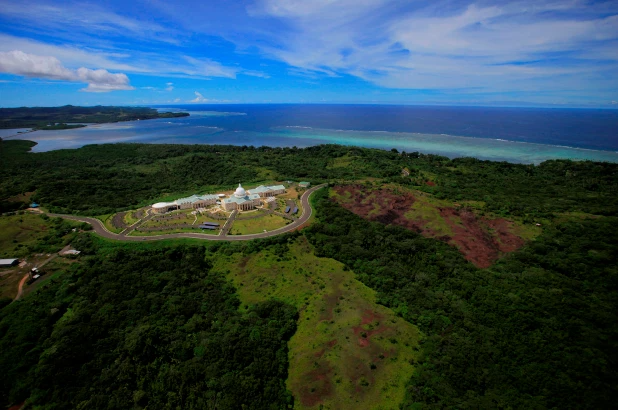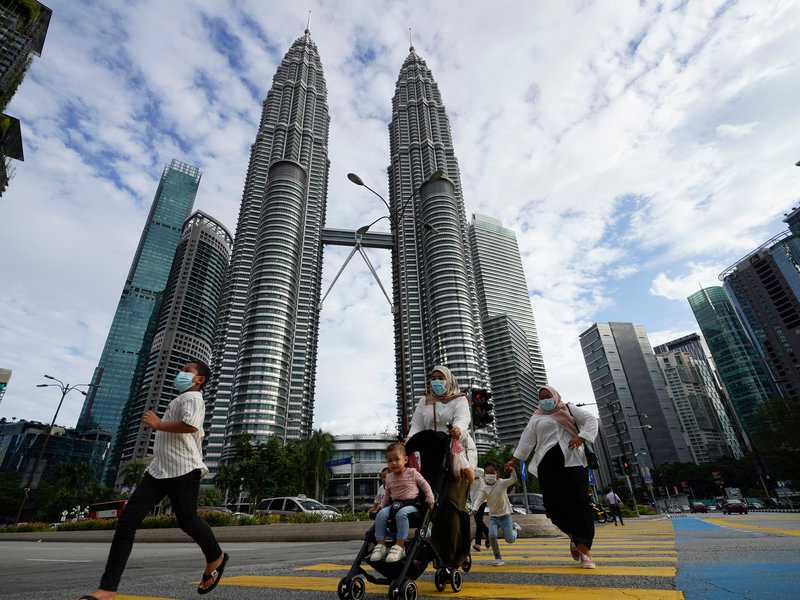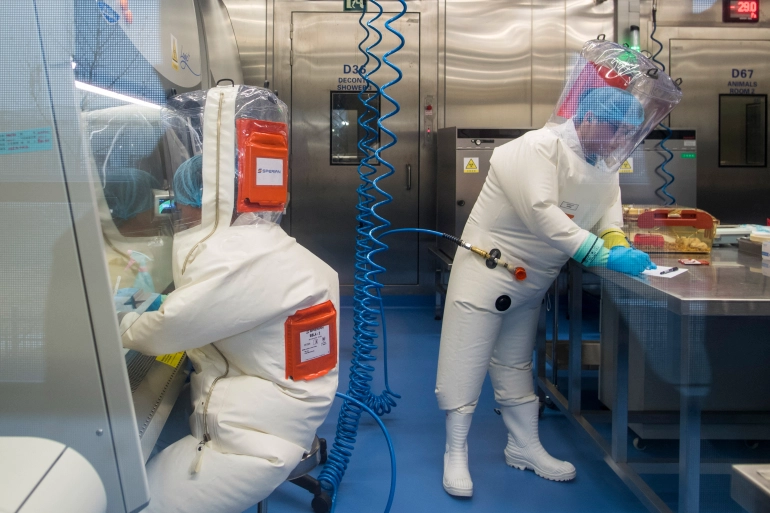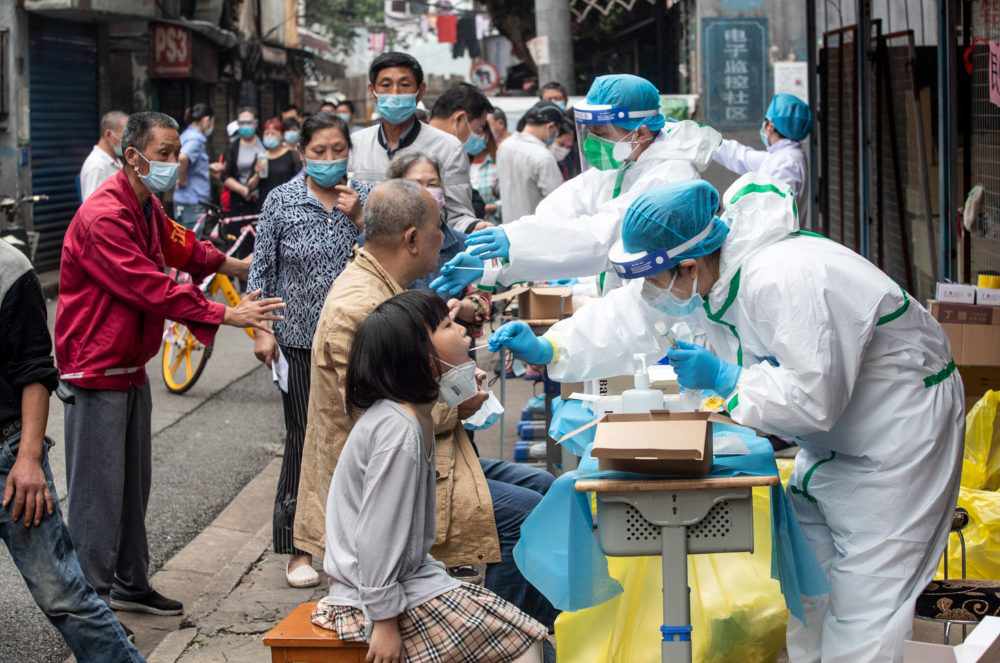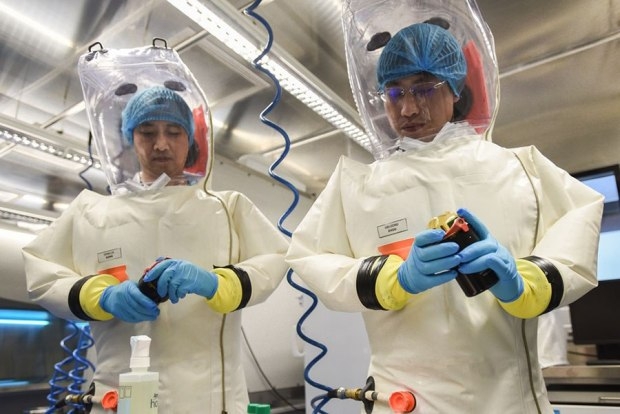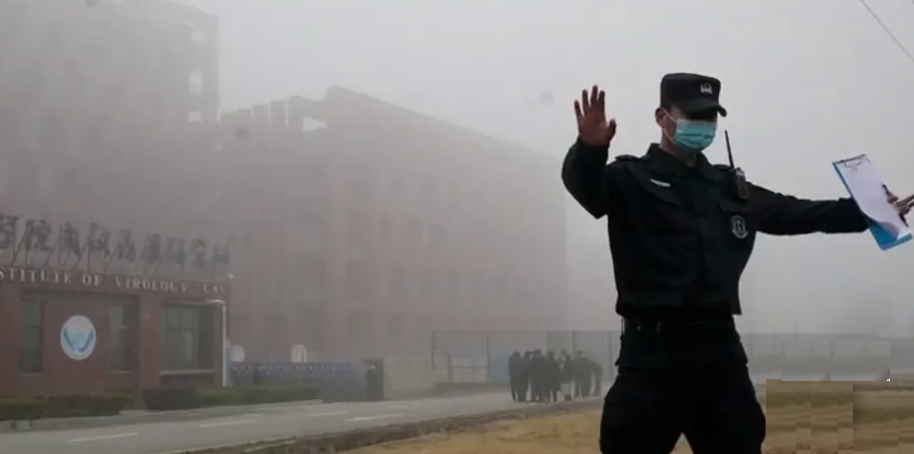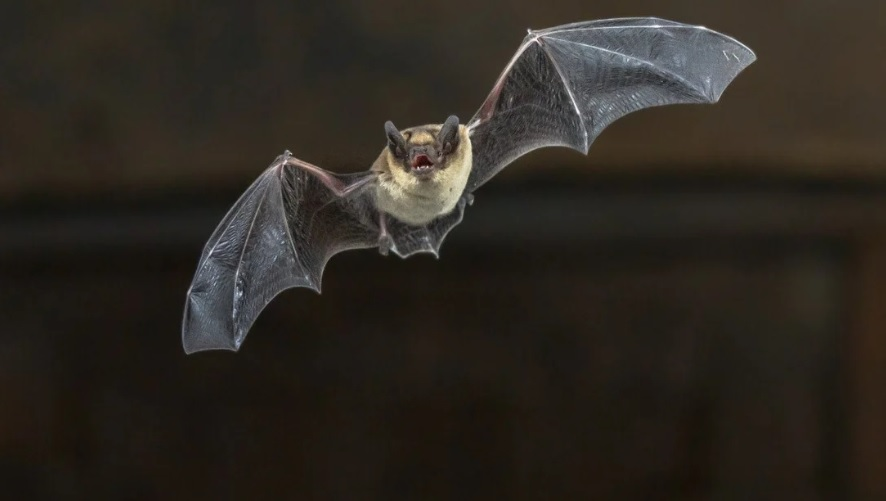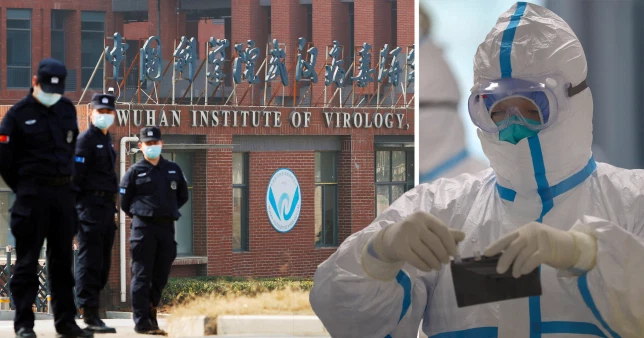Beijing released new conspiracy about US amid WHO's Covid investigation in China
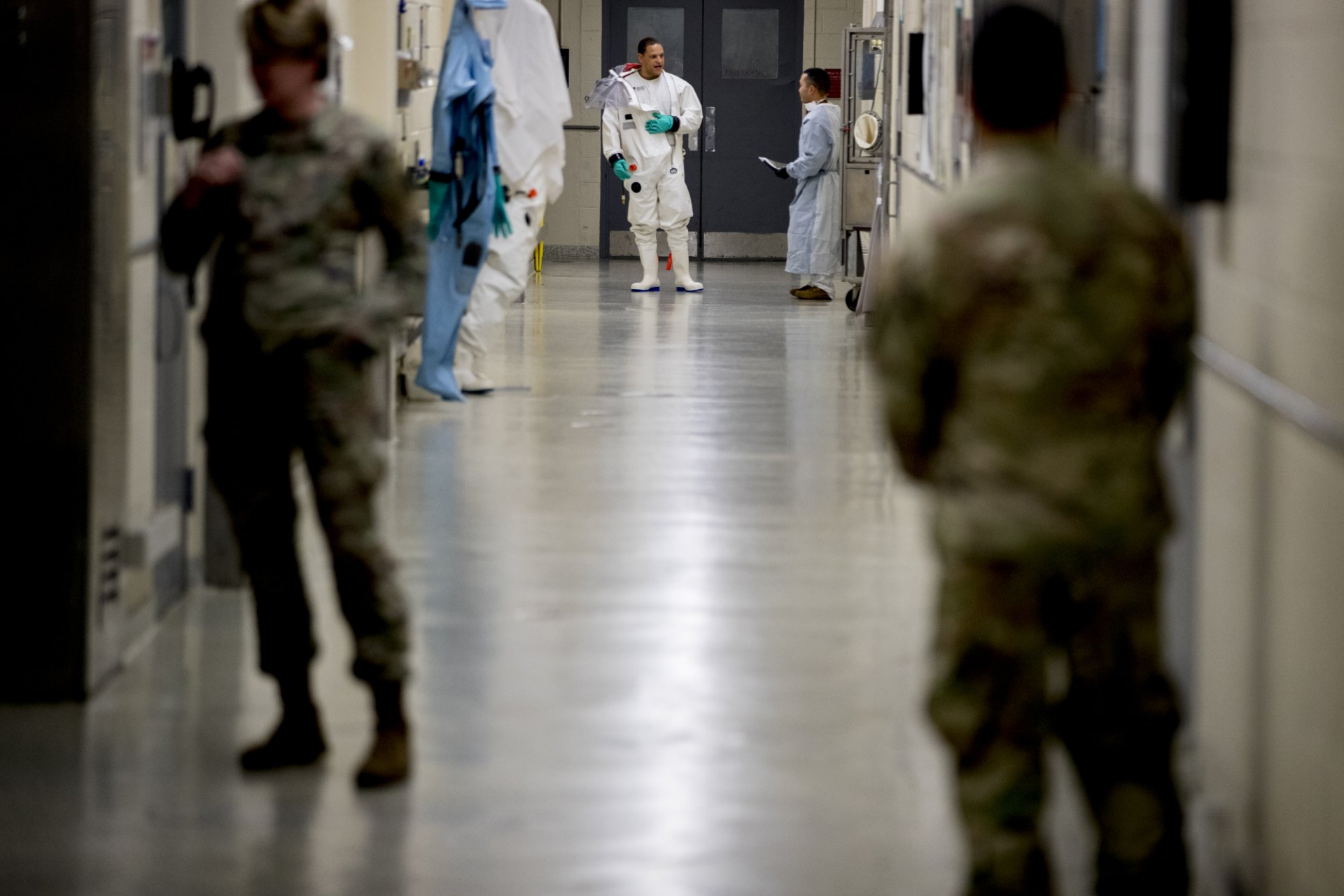 |
| In this March 19, 2020 file photo, biological science specialists, background, wear biosafety protective clothing for handling viral diseases at U.S. Army Medical Research and Development Command at Fort Detrick in Frederick, Md. (AP Photo/Andrew Harnik) |
"(We hope) that following China's example, the US side will act in a positive, science-based and cooperative manner on the origin-tracing issue (and) invite WHO experts in for an origin-tracing study," Foreign Ministry spokesman Wang Wenbin said last week, according to CNN.
Going even further, Zeng Guang, chief epidemiologist at China's Center for Disease Control, said the US should now be "the focus" of global efforts to trace the virus.
That Chinese officials should point to the US when discussing the origins of a virus first detected in central China may at first appear confusing to many.
But for months now, China has been advancing alternative theories for how the coronavirus first emerged, ones that would obviate any blame officials in Wuhan may bear for not reacting quickly enough to the initial outbreak in that city in late 2019, during which they are accused of dragging their feet as evidence of human-to-human spread became clear and the virus ran rampant.
One Chinese theory in particular emerged early on in the pandemic but gained significant traction in recent weeks, as the WHO investigation and new outbreaks of the coronavirus in China renewed attention both internally and externally on the government's alleged failures.
In many ways, this theory is the mirror image of a conspiracy about China alleging that the virus might have emerged -- either intentionally or by mistake -- from a lab in Wuhan focused on researching deadly pathogens. That this did not happen is one of the few definitive statements the WHO team were able to make after their trip to the city this month.
"(Our) findings suggest that the laboratory incident hypothesis is extremely unlikely to explain introduction of the virus into the human population, and therefore is not a hypothesis that implies to suggest future studies into our work, to support our future work, into the understanding of the origin of the virus," Peter Ben Embarek, a member of the team, said at a press conference announcing their findings held before the team left China.
At the same time, however, Zeng, the Chinese CDC official, was advancing just such a hypothesis, not about the Wuhan lab, but Fort Detrick, a US Army biomedical research laboratory in Maryland. There is no evidence to support this theory.
"The US has biological laboratories all over the world," he told a Shanghai-based website, in an interview which linked Fort Detrick, and the US Army Medical Research Institute of Infectious Diseases (USAMRIID) based there, to research carried out by the notorious Unit 731 of the Japanese Imperial Army during World War II.
"Why does the US have so many laboratories? What is the purpose of this?" Zeng said. "In many things, the US requires others to be open and transparent. In the end, it turns out that the US itself is often the most opaque."
The idea that the coronavirus may have emerged from a lab, that the pandemic which ground the world to a halt may have been man-made, is not isolated to China. Many US politicians and conspiracists have pushed the idea that a Chinese lab might have been responsible, while others have posited alternative supposed bioweapon creators, including the US itself.
“Lab conspiracy”
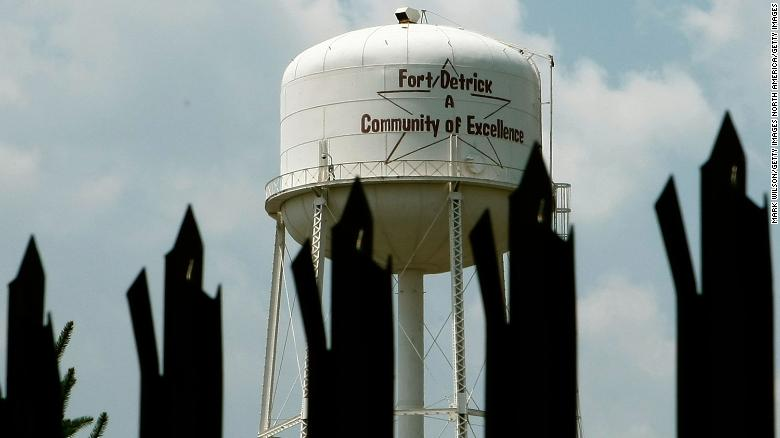 |
| Fort Detrick, a US Army base in Maryland, has become the focus of Chinese conspiracy theories about the coronavirus. (Photo: CNN) |
By March, just three months after COVID-19 appeared in central China, belief that the virus had been created in a lab and possibly weaponized was widespread, multiple surveys showed. The Pew Research Center found, for example, that one in three Americans believed the new coronavirus had been created in a lab; one in four thought it had been engineered intentionally. In Iran, top leaders cited the bioweapon conspiracy to justify their refusal of foreign medical aid. Anti-lockdown and anti-mask groups around the world called COVID-19 a hoax and a weapon, complicating public health efforts to slow the spread.
“This is like a virus, like COVID, a media pathogen,” said Kang Liu, a professor at Duke University who studies cultural politics and media in China, comparing the spread of disinformation about the virus to the spread of the virus itself. “We have a double pandemic -- the real pathological virus and the pandemic of fear. The fear is what is really at stake.”
On Feb. 7, Li Wenliang, a Chinese doctor punished for circulating an early warning about the outbreak, died of COVID-19. The outpouring of grief and rage sparked by Li’s death was an unusual – and for the ruling Communist Party, unsettling -- display in China’s tightly monitored civic space.
Meanwhile, powerful voices in the U.S. -- from former President Trump to congressional Republicans -- were working to rebrand COVID-19 as “the China virus,” amplifying fringe theories that it had been engineered by Chinese scientists.
Social media accounts that appeared to be pro-Trump or QAnon followers pushed the disinformation, repeatedly retweeting identical content that claimed China created the virus as a bioweapon, researchers at the Australia Institute’s Centre for Responsible Technology found.
On March 9, a public WeChat account called Happy Reading List reposted an essay claiming the U.S. military created SARS-CoV-2, the virus that causes COVID-19, at a lab at Fort Detrick, in Maryland, and loosed it in China during the Military World Games, an international competition for military athletes, held in Wuhan in October 2019, Associated Press reported.
The account, which has been suspended, was registered in May 2019 by a woman from Henan province in central China, who did not reply to messages. It’s not clear who first wrote the article, which can still be found on other WeChat accounts.
The next day an anonymous petition appeared on the White House’s now-defunct “We the People” portal. It urged U.S. authorities to clarify whether the virus had been developed at Fort Detrick and leaked from the lab. The petition was lavishly covered by China’s state media, despite getting only 1,426 signatures, far shy of the 100,000 needed to merit a response from the White House.
On March 11, Larry Romanoff, who claims to be a former management consultant based in Shanghai, posted an article on Global Research Canada that cribbed heavily from the Happy Reading List posting, citing it as a source.
“There have been a number of stories where the origin of a story is in Russian-controlled space but it’s picked up by Global Research and then put forward as their own story. Then you get Russian media saying western analysts in Canada say that. We call that information laundering,” said Sarts, the NATO StratCom director. “They have been helpful for a long time to Russian information operations and recently to the Chinese as well.”
Neither Romanoff nor Global Research responded to requests for comment.
The day of Romanoff’s article, the World Health Organization officially designated the COVID-19 outbreak a pandemic.
By May, as relations between the US and China continued to plummet over the coronavirus pandemic, and Trump's attempts to divert from his administration's handling of it, the Fort Detrick conspiracy reached the mouths of China's top diplomats.
At a press conference on May 6, in response to a question about the Wuhan lab origin, Foreign Ministry spokeswoman Hua Chunying referenced reports about Fort Detrick, and called on the US government to "accept investigation and address these concerns," driving the theory fully into the mainstream in China, with numerous outlets publishing reports on the alleged "cover-up," while a widely-shared video compared it to Unit 731.
As China largely recovered from the pandemic and returned to normal in the latter half of 2020, the Fort Detrick theory faded from consciousness somewhat, replaced by more plausible -- though highly contested -- claims that the virus might have been circulating in other countries and could have entered Wuhan via frozen food supply chains, a theory the WHO team offered a tacit endorsement of this month in a press conference, saying it was worth further investigation, CNN reported.
Media influence
A video of Hua, uploaded by the state-backed Beijing News, was viewed almost a million times on Weibo, the Chinese Twitter-like service. The clip was then picked up by a number of leading Chinese influencers, with millions of followers between them, many of whom appear to be managed by the same marketing company, according to a CNN examination of posts and user profiles.
Today, the video of Hua speaking has been viewed 74 million times, with individual comments on the post receiving hundreds of thousands of upvotes alone, such as one which reads "if MOFA said so, then it can't be unsubstantiated" receiving over 360,000 likes.
Wu, the New York University professor, pointed to China's frequent campaigns against "online rumors," which are used both to crack down on disinformation as well as more legitimate criticism of the government.
"Calling something 'rumors' infers a powerful authority whose judgment is instituted and enforced," she said. "Reversely, when such an authority advances an official account that is unverifiable, surely its influences on the public are extraordinary."
According to analysis of Weibo data, around the time the Hua video was going viral, a "Foreign Ministry" hashtag attracted more than 210,000 posts between January 18 and 25, with 790 million views. In the same period, 229,000 posts using the "Fort Detrick" hashtag were viewed more than 1.48 billion times.
Many of the most popular posts were from state-run media and nominally private publications with close links to the government, but others were shared by celebrities, influencers, and accounts which usually focus on entertainment news. For example, several fan accounts for popular actors shifted focus to Fort Detrick for a period, sharing news stories about the conspiracy theory to their hundreds of thousands of followers and allowing it to spread to a broader group which usually did not focus on politics, CNN reported.
Wu said it was common for supposedly non-political accounts to be used in what is called "online public opinion guidance," including "through commercial deals."
"How it works in China bears resemblance to the commercial sector in Western countries where marketing firms take money to help their clients, including politicians and campaign organizers, by orchestrating all kinds of KOLs to amply their messages on social media," she said, using an acronym for "key opinion leaders."
CNN has been unable to reach several of the most popular influencer accounts posting about Fort Detrick, and there is no evidence to suggest definitively that they were paid or induced to spread the message, they could have been posting about the theory simply because it was a popular news story at the time.
According to the DFRLab-AP report, conspiracies about Fort Detrick which emerged on the Chinese language web later spread worldwide via Facebook and other platforms, and were picked up by politicians in Russia and Iran.
Meanwhile back in China, the country's propaganda organs have claimed vindication after the WHO investigation, and attacked both Washington and western media for questioning its findings.
"The WHO expert team has almost ruled out the possibility that the COVID-19 was leaked by Wuhan Institute of Virology, and opened the door to the theory that the virus might have been present outside China before the outbreak in Wuhan. This is a scientific judgment," the Global Times, a nationalist state-run tabloid, said in an editorial, adding that US media "are one of the most active forces in the West's weaving terrifying lies against China."
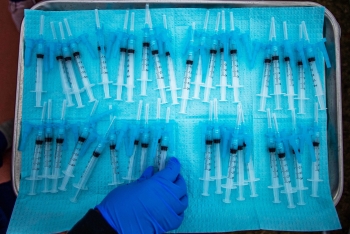 | World breaking news today (Feb 19): U.S. send $2 billion to WHO's COVAX program World breaking news today (Feb 19): U.S. send $2 billion to WHO's COVAX program. Meanwhile, US says it is willing to sit down for talks ... |
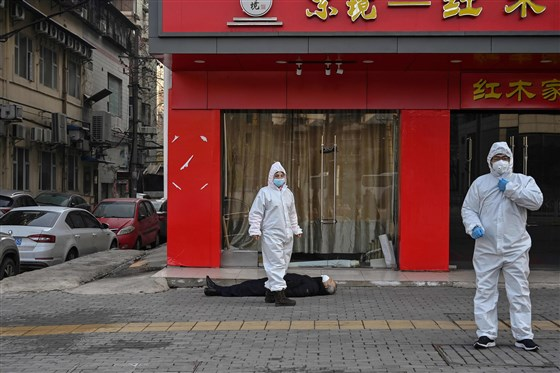 | WHO discards the "Wuhan lab theory" about COVID's origin, saying it is "extremely unlikely" The World Health Organization (WHO) has dismissed the "lab theory" while investigating for the origin of the coronavirus pandemic, saying that virus leaking from a ... |
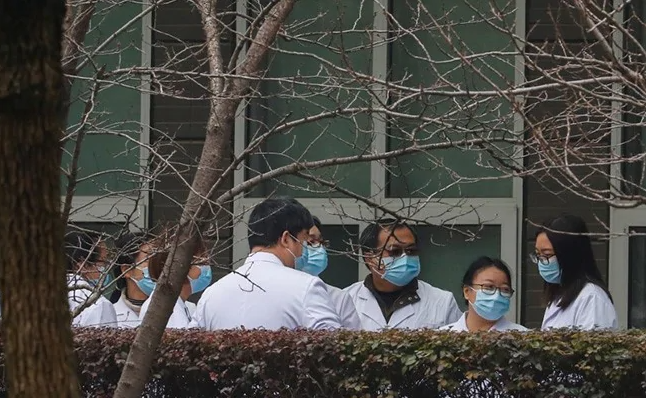 | China's Role In Coronavirus Outbreak: What WHO investigation team have found? WHO team of experts are on their way to conclude a lengthy and crucial investigation into the origins of the novel coronavirus and have found ... |
In topics
Recommended
 World
World
US, China Conclude Trade Talks with Positive Outcome
 World
World
Nifty, Sensex jumped more than 2% in opening as India-Pakistan tensions ease
 World
World
Easing of US-China Tariffs: Markets React Positively, Experts Remain Cautious
 World
World
India strikes back at terrorists with Operation Sindoor
Popular article
 World
World
India sending Holy Relics of Lord Buddha to Vietnam a special gesture, has generated tremendous spiritual faith: Kiren Rijiju
 World
World
Why the India-US Sonobuoy Co-Production Agreement Matters
 World
World
Vietnam’s 50-year Reunification Celebration Garners Argentine Press’s Attention
 World
World

